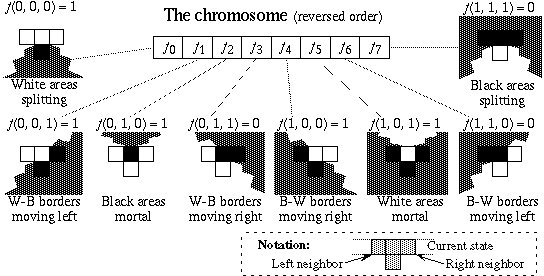
The chromosome, or the look-up table, contains eight genes, f0, f1, ..., f7, each of which is one-bit length. These genes can be interpreted as follows.
Several examples shown in the previous section are analyzed using the interpretation above.
#226 (= 11100010): Firstly, gene f0 is 0 and gene f7 is 1. Thus, both white and black domains in patterns C1 and C2 do not split. Secondly, f2 is 0 and f5 is 1. Thus, both white and black domains are mortal. Black domains actually die in C1 and C2. All the black domains die if the random order is used. However, some black domains continue to exist if the interlaced order is used, because gene f7 is not used for the state transitions of such domains. Thus, the properties of the automata are only partially expressed when no noise exists. Thirdly, f1 is 1 and f3 is 0. Thus, WB borders can move in both directions. They actually move in both directions in C1. However, they move in single direction in a period in C2. This is another example of partial expression of genes under noise-free situations. Fourth, f6 is 1 and f4 is 0. Thus, BW borders do not move. This property is expressed both in C1 and C2.
#166 (= 10100110): f0 is 0 and f7 is 1. Thus, both white and black domains in patterns F1 and F2 do not split. Both f2 and f5 are 1. Thus, black domains are immortal and white domains are mortal. White domains die in C1, but they continue to exist after the automaton comes into a limit cycle in C2. This is another example of partial expression of genes. Expression and suppression of other genes can easily be observed.
#58 (= 00111010): Black domains can split because f0 is 0, but white domains do not split because f7 is 0. Expression of gene f0 can easily be seen in G1, but this property is also suppressed in G2. Expression and suppression of other genes can easily be observed.
Other patterns, such as those shown in Sections 3.1 to 3.3, can be explained in the same way.
The above simpler relation between the look-up table values and the property of patterns exist only if the computation is asynchronous (sequential). Synchronous or partially synchronous (partially concurrent) automata cannot be mostly explained using the above interpretation. It is much more difficult to analyze these automata. The existence of the above relation seems to relate to some conservation law, which is broken in synchronous or partially synchronous automata.